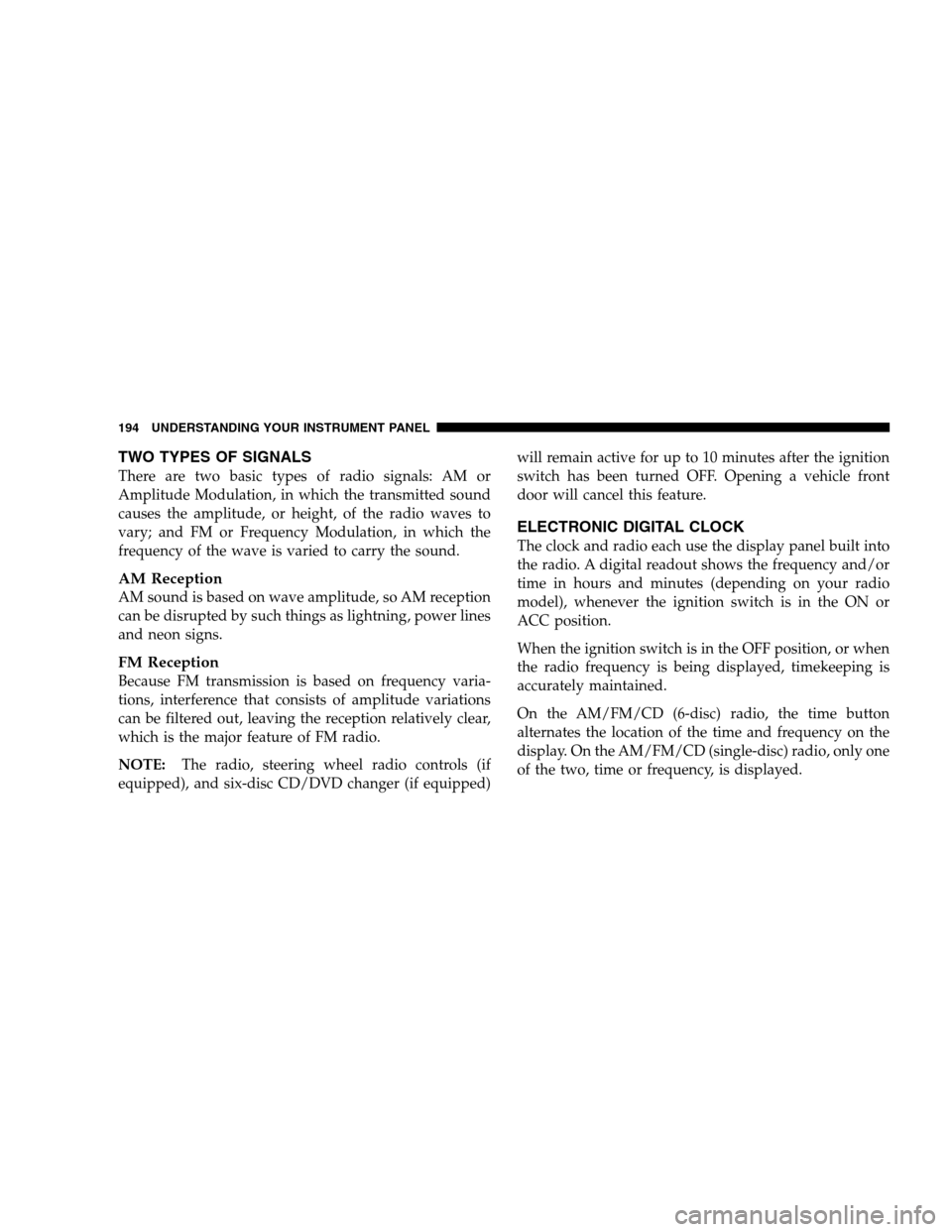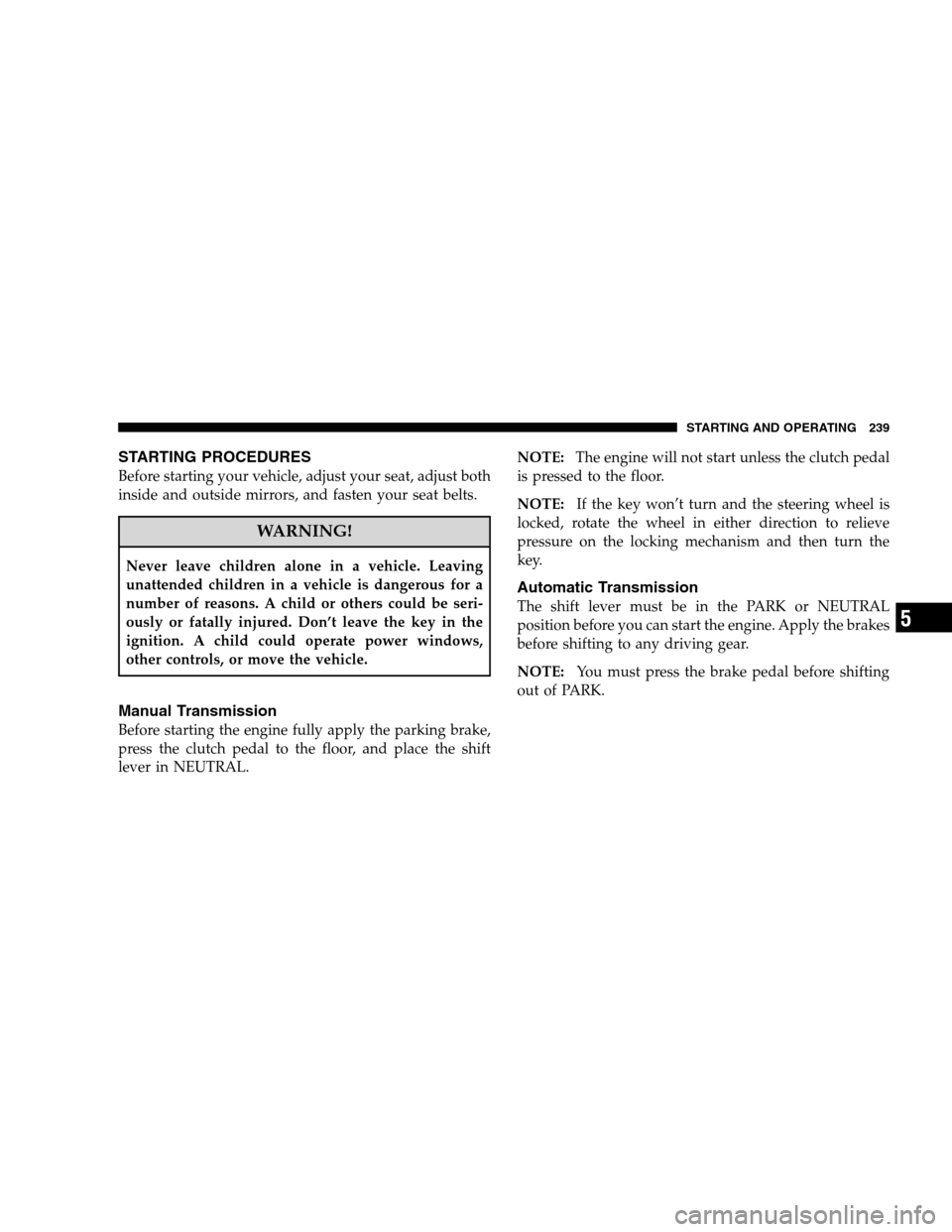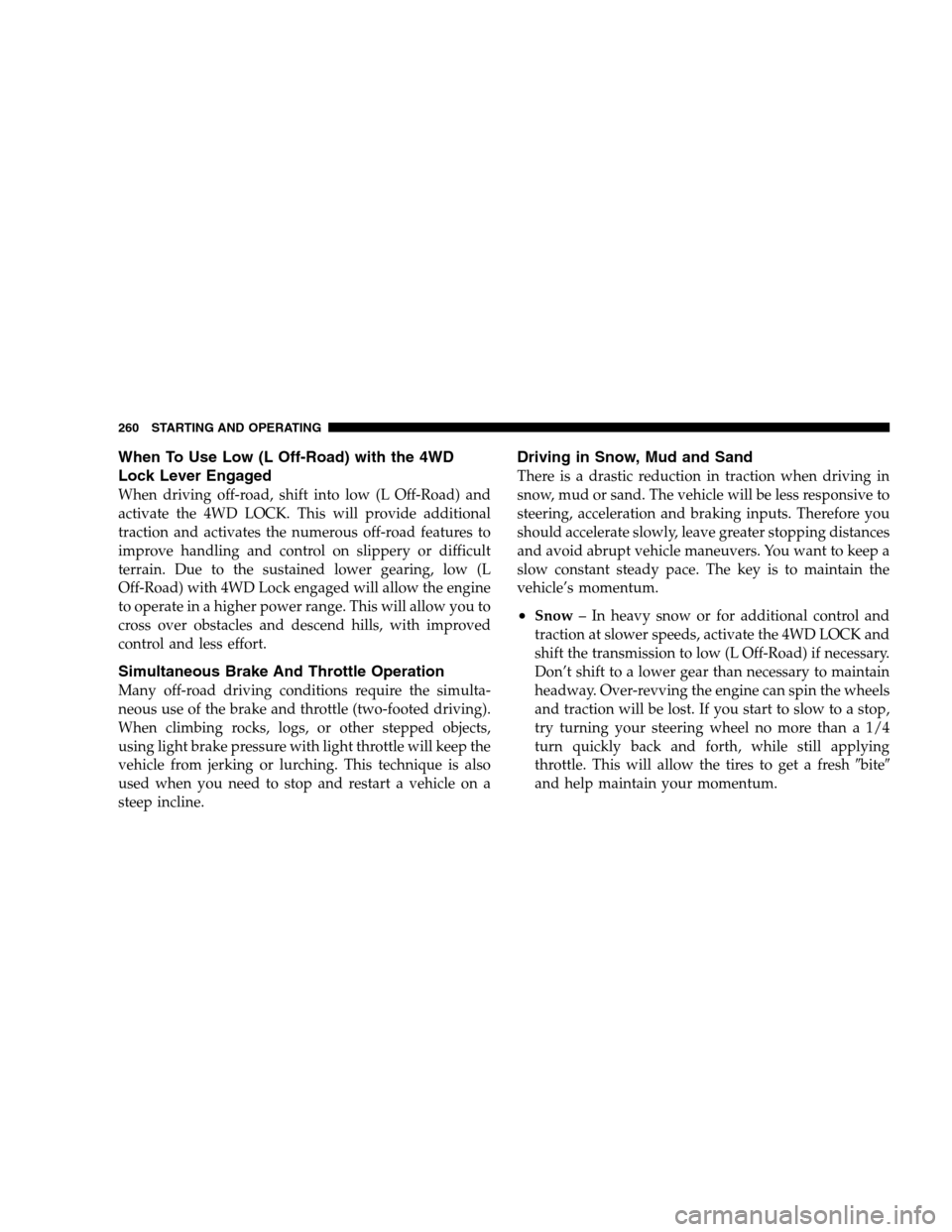Page 196 of 438

TWO TYPES OF SIGNALS
There are two basic types of radio signals: AM or
Amplitude Modulation, in which the transmitted sound
causes the amplitude, or height, of the radio waves to
vary; and FM or Frequency Modulation, in which the
frequency of the wave is varied to carry the sound.
AM Reception
AM sound is based on wave amplitude, so AM reception
can be disrupted by such things as lightning, power lines
and neon signs.
FM Reception
Because FM transmission is based on frequency varia-
tions, interference that consists of amplitude variations
can be filtered out, leaving the reception relatively clear,
which is the major feature of FM radio.
NOTE:The radio, steering wheel radio controls (if
equipped), and six-disc CD/DVD changer (if equipped)will remain active for up to 10 minutes after the ignition
switch has been turned OFF. Opening a vehicle front
door will cancel this feature.
ELECTRONIC DIGITAL CLOCK
The clock and radio each use the display panel built into
the radio. A digital readout shows the frequency and/or
time in hours and minutes (depending on your radio
model), whenever the ignition switch is in the ON or
ACC position.
When the ignition switch is in the OFF position, or when
the radio frequency is being displayed, timekeeping is
accurately maintained.
On the AM/FM/CD (6-disc) radio, the time button
alternates the location of the time and frequency on the
display. On the AM/FM/CD (single-disc) radio, only one
of the two, time or frequency, is displayed.
194 UNDERSTANDING YOUR INSTRUMENT PANEL
Page 226 of 438
Reception Quality
Satellite reception may be interrupted due to one of the
following reasons:
•The vehicle is parked in an underground parking
structure or under a physical obstacle.
•Dense tree coverage may interrupt reception.
•Driving under wide bridges or along tall buildings can
cause intermittent reception.
•Placing objects over or too close to the antenna can
cause signal blockage.
REMOTE SOUND SYSTEM CONTROLS — IF
EQUIPPED
The remote sound system controls are located on the rear
surface of the steering wheel. Reach behind the wheel to
access the switches.The right-hand control is a rocker type switch with a
pushbutton in the center. Pressing the top of the switch
will increase the volume and pressing the bottom of the
switch will decrease the volume.
The button located in the center of the right-hand control
will switch modes to Radio or CD.
224 UNDERSTANDING YOUR INSTRUMENT PANEL
Page 239 of 438

�Brake System..........................278
▫Anti-Lock Brake System (ABS) —
If Equipped.........................279
�Power Steering........................282
�Tire Safety Information...................283
▫Tire Markings........................283
▫Tire Loading And Tire Pressure...........287
�Tires — General Information...............291
▫Tire Pressure.........................291
�Tire Chains...........................300
�Tire Rotation Recommendations............300
�Tire Pressure Monitoring System (TPMS) —
If Equipped...........................301
▫Base System — If Equipped..............304▫Premium System — If Equipped..........306
▫General Information...................310
�Snow Tires...........................310
�Fuel Requirements......................311
▫Gasoline Engines.....................311
▫Reformulated Gasoline.................311
▫Gasoline/Oxygenate Blends..............312
▫MMT In Gasoline.....................312
▫Materials Added To Fuel................313
▫Fuel System Cautions..................313
▫Carbon Monoxide Warnings..............314
�Adding Fuel..........................314
▫Fuel Filler Cap (Gas Cap)...............314
STARTING AND OPERATING 237
5
Page 241 of 438

STARTING PROCEDURES
Before starting your vehicle, adjust your seat, adjust both
inside and outside mirrors, and fasten your seat belts.
WARNING!
Never leave children alone in a vehicle. Leaving
unattended children in a vehicle is dangerous for a
number of reasons. A child or others could be seri-
ously or fatally injured. Don’t leave the key in the
ignition. A child could operate power windows,
other controls, or move the vehicle.
Manual Transmission
Before starting the engine fully apply the parking brake,
press the clutch pedal to the floor, and place the shift
lever in NEUTRAL.NOTE:The engine will not start unless the clutch pedal
is pressed to the floor.
NOTE:If the key won’t turn and the steering wheel is
locked, rotate the wheel in either direction to relieve
pressure on the locking mechanism and then turn the
key.
Automatic Transmission
The shift lever must be in the PARK or NEUTRAL
position before you can start the engine. Apply the brakes
before shifting to any driving gear.
NOTE:You must press the brake pedal before shifting
out of PARK.
STARTING AND OPERATING 239
5
Page 250 of 438

The following indicators should be used to ensure that
you have engaged the transmission shift lever into the
PARK position:
•When shifting into PARK, firmly move the shift lever
all the way forward until it stops.
•Look at the shift indicator window on the shift lever
bezel to ensure it is in the PARK position.
•You must depress the brake pedal to move the shift
lever out of the PARK position.
CAUTION!
Before moving the shift lever out of PARK, you must
turn the ignition from LOCK to ON so the steering
wheel and shift lever are released. Otherwise, dam-
age to the steering column or shift lever could result.
You must also depress the brake pedal.
REVERSE
Shift into this range only after the vehicle has come to a
complete stop.
NEUTRAL
The engine may be started in this range.
DRIVE
This should be used for most driving and provides the
best ratio for optimum drivability, fuel economy, and
performance.
LOW
This range should be used for maximum engine braking
when descending steep grades. In this range, the trans-
axle will ratio up only to prevent transaxle damage or
engine over-speed, while ratio down will occur as early
as possible
248 STARTING AND OPERATING
Page 261 of 438

The Basics of Off-Road Driving
You will encounter many types of terrain driving off-
road. You should be familiar with the terrain and area
before proceeding. There are many types of surface
conditions: hard packed dirt, gravel, rocks, grass, sand,
mud, snow and ice. Every surface has a different effect on
your vehicle’s steering, handling and traction. Control-
ling your vehicle is one of the keys to successful off-road
driving, so always keep a firm grip on the steering wheel
and maintain a good driving posture. Avoid sudden
accelerations, turns or braking. In most cases there are no
road signs, posted speed limits or signal lights. Therefore
you will need to use your own good judgment on what is
safe and what isn’t. When on a trail you should always be
looking ahead for surface obstacles and changes in
terrain. The key is to plan your future driving route while
remembering what you are currently driving over.CAUTION!
Never park your vehicle over dry grass or other
combustible materials. The heat from your vehicle
exhaust system could cause a fire.
WARNING!
Always wear your seat belt and firmly tie down
cargo. Unsecured cargo can become projectiles in an
off-road situation.
STARTING AND OPERATING 259
5
Page 262 of 438

When To Use Low (L Off-Road) with the 4WD
Lock Lever Engaged
When driving off-road, shift into low (L Off-Road) and
activate the 4WD LOCK. This will provide additional
traction and activates the numerous off-road features to
improve handling and control on slippery or difficult
terrain. Due to the sustained lower gearing, low (L
Off-Road) with 4WD Lock engaged will allow the engine
to operate in a higher power range. This will allow you to
cross over obstacles and descend hills, with improved
control and less effort.
Simultaneous Brake And Throttle Operation
Many off-road driving conditions require the simulta-
neous use of the brake and throttle (two-footed driving).
When climbing rocks, logs, or other stepped objects,
using light brake pressure with light throttle will keep the
vehicle from jerking or lurching. This technique is also
used when you need to stop and restart a vehicle on a
steep incline.
Driving in Snow, Mud and Sand
There is a drastic reduction in traction when driving in
snow, mud or sand. The vehicle will be less responsive to
steering, acceleration and braking inputs. Therefore you
should accelerate slowly, leave greater stopping distances
and avoid abrupt vehicle maneuvers. You want to keep a
slow constant steady pace. The key is to maintain the
vehicle’s momentum.
•Snow– In heavy snow or for additional control and
traction at slower speeds, activate the 4WD LOCK and
shift the transmission to low (L Off-Road) if necessary.
Don’t shift to a lower gear than necessary to maintain
headway. Over-revving the engine can spin the wheels
and traction will be lost. If you start to slow to a stop,
try turning your steering wheel no more than a 1/4
turn quickly back and forth, while still applying
throttle. This will allow the tires to get a fresh�bite�
and help maintain your momentum.
260 STARTING AND OPERATING
Page 263 of 438

CAUTION!
On icy or slippery roads, do not downshift at high
engine RPM’s or vehicle speeds because engine brak-
ing may cause skidding and loss of control.
•Mud–Deep mud creates a great deal of suction around
the tires and is very difficult to get through. You should
use low (L Off-Road) with the 4WD LOCK engaged and
maintain your momentum. If you start to slow to a stop,
try turning your steering wheel no more than a 1/4 turn
quickly back and forth for additional traction. Mud
holes pose an increased threat of vehicle damage and
getting stuck. They are normally full of debris from
previous vehicles getting stuck. As a good practice
before entering any mud hole, get out and determine
how deep it is, if there are any hidden obstacles and if
the vehicle can be safely recovered if stuck.
•Sand– Soft sand is very difficult to travel through
with full tire pressure. When crossing soft sandy spots
in a trail maintain your vehicle’s momentum and do
not stop. The key to driving in soft sand is using the
appropriate tire pressure, accelerating slowly, avoid-
ing abrupt maneuvers and maintaining the vehicle’s
momentum. If you are going to be driving on large soft
sandy areas or dunes, reduce your tire pressure to a
minimum of 15 psi (103 kPa) to allow for a greater tire
surface area. You should use low (L Off-Road) with the
4WD LOCK engaged and ESP turned off. Reduced tire
pressure will drastically improve your traction and
handling, while driving on the soft sand, but you must
return the tires to normal air pressure before driving
on pavement or other hard surfaces. Be sure you have
a way to reinflate the tires prior to reducing the
pressure.
STARTING AND OPERATING 261
5